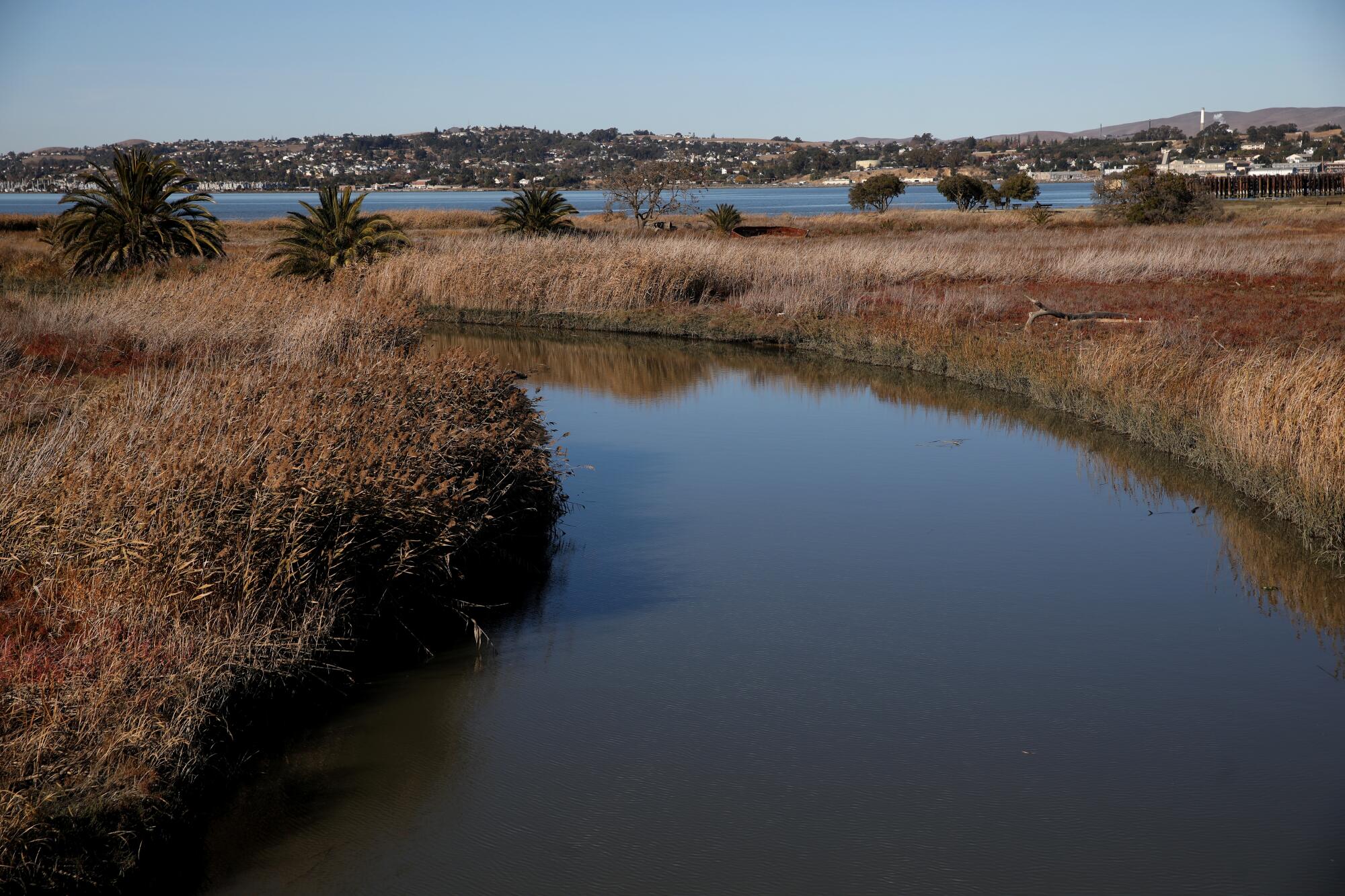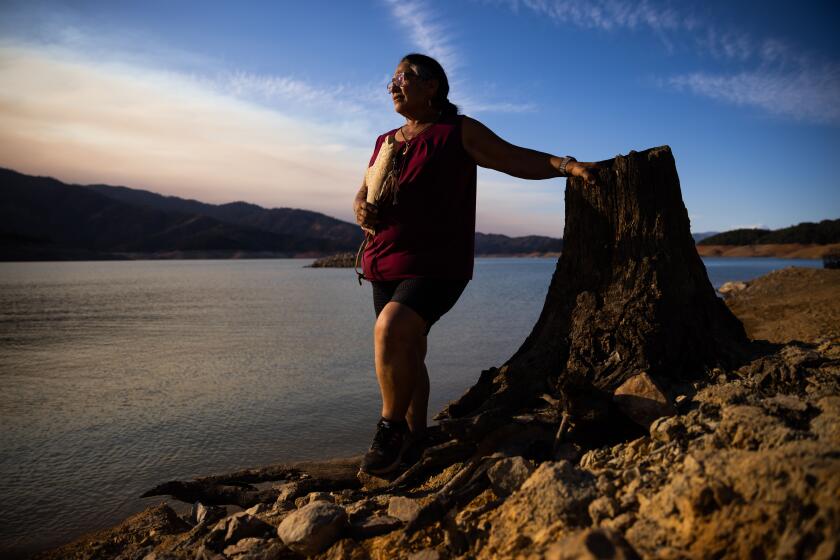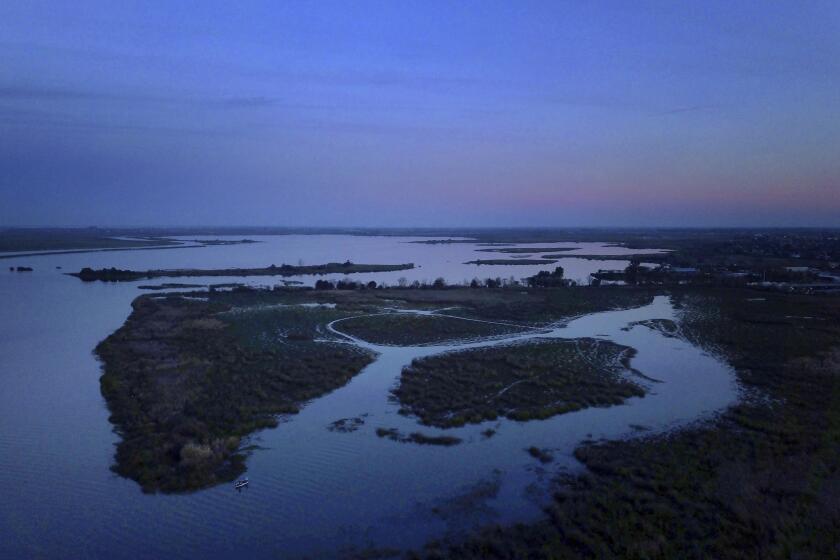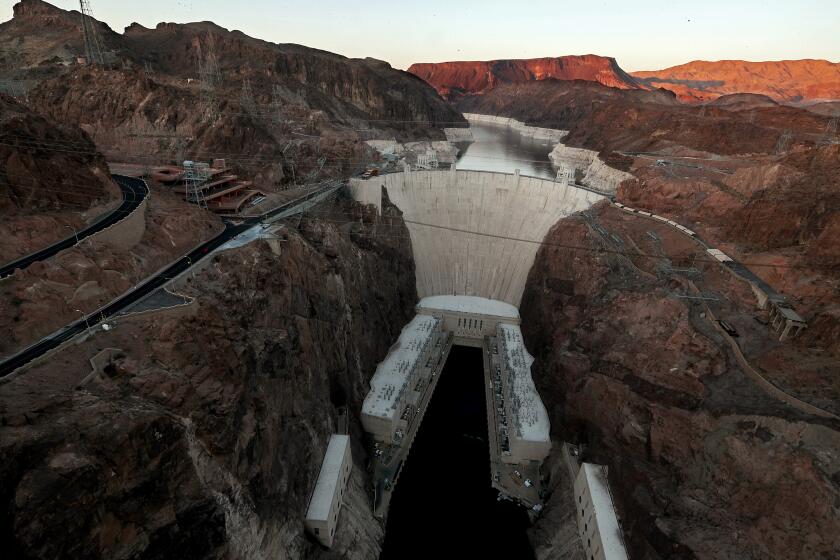
In the face of heavy opposition from environmental groups, Gov. Gavin Newsom and his administration are pushing forward with a controversial plan to build a 45-mile water tunnel beneath the Sacramento-San Joaquin River Delta — a project the governor says is vital to modernizing the state’s aging water system.
State officials released their final environmental analysis of the proposed delta tunnel project on Friday, signaling the start of a process of seeking permits to build the tunnel that would use massive pumps to transfer water from the Sacramento River to cities and farmlands to the south.
Newsom and state water managers say the tunnel would help California adapt to worsening cycles of drought fueled by climate change and capture more water during wet periods. They say it would also help address the risks to infrastructure posed by earthquakes and flooding.
“Climate change is threatening our access to clean drinking water, diminishing future supplies for millions of Californians,” Newsom said in a written statement. “Doing nothing is not an option. After the three driest years on record, we didn’t have the infrastructure to fully take advantage of an exceptionally wet year, which will become more and more critical as our weather whiplashes between extremes.”
Aggressive and impactful reporting on climate change, the environment, health and science.
Environmental groups have condemned the plan, saying the tunnel would seriously harm the delta’s deteriorating ecosystem and threaten fish species that are already on the brink. Opponents argue that the funds needed to build the tunnel would be better spent on groundwater recharge efforts, water recycling, and stormwater capture, among other projects.
Debate over the project has been simmering for decades. Former Gov. Jerry Brown sought a two-tunnel proposal, calling the project WaterFix. Newsom has supported a redesigned project with a single tunnel, called the Delta Conveyance Project.
The plan calls for a concrete tunnel 36 feet wide and running 140 to 170 feet underground, connecting to a new pumping plant that would send water into the California Aqueduct.
Construction costs have previously been estimated at $16 billion, but the state plans to update those cost estimates next year.
California officials say the tunnel’s two proposed intakes on the Sacramento River would allow the system to capture and transport more water during wet periods. State water managers say the current infrastructure makes for missed opportunities when large quantities of stormwater are allowed to flow through the delta and into the Pacific Ocean during rainy periods, such as last winter.
Tunnel supporters say the project would improve California’s ability to withstand worsening droughts and intense swings between wet and dry periods.
“We really don’t have time to waste in terms of getting all projects moving forward that can secure California in this new hydrologic scenario,” said Karla Nemeth, director of the state Department of Water Resources.
Nemeth said the increase in water availability from the delta would be “pegged to those times when we do have those high flows,” rather than during dry times.
“Ultimately, it really is triggered by intense pulse conditions,” she said.
Officials estimated that if the tunnel had been in place during the torrential storms in January, the state could have captured and moved an additional 228,000 acre-feet of water, enough to supply about 2.3 million people for a year.
“We need to preserve the backbone of our water system,” said Wade Crowfoot, the state’s natural resources secretary.
Crowfoot said without this update, the existing water system is vulnerable to the effects of climate change as well as potential damage from a large earthquake, which could disrupt water deliveries for 27 million Californians. He said a quake could render the system unusable for months or more than a year, which he said would be “the largest catastrophe in any water system in America.”
“To ensure that our conveyance is both climate-resilient and earthquake-resilient, we need to modernize this infrastructure,” he said.
California tribes and environmental groups argue state officials are violating civil rights by mismanaging water. The EPA is opening an investigation.
Environmentalists and other critics argue that the state is failing to see the big picture and has based the project on outdated climate science.
“Like its predecessor, the WaterFix Project, the Delta Conveyance Project fails to consider or address the risks from accelerating climate change impacts to Sacramento and San Joaquin River watersheds and the delta,” said Deirdre Des Jardins, an independent water researcher.
Des Jardins and a coalition of environmental and fishing advocates said in recent written comments that the project faces major uncertainties, “including worsening climate change impacts on water supply and sea level rise, coupled with the need to reduce exports in order to increase freshwater flows through the delta.” They also said the state has failed to consider non-tunnel alternatives.
For the record:
3:46 p.m. Dec. 11, 2023A previous version of this story misspelled Barbara Barrigan-Parrilla’s name as Barrigan-Parilla.
Newsom’s tunnel proposal, as outlined in the state’s final environmental impact report, is “another failure of state water officials to imagine alternative approaches in a climate-impacted California,” said Barbara Barrigan-Parrilla, executive director of the group Restore the Delta.
“The big pipe engineering solutions of the last century are no longer the way forward in California water’s climate-changed reality,” Barrigan-Parrilla said. The latest delta tunnel plan, she said, is “out of date for climate change science” and will quickly be obsolete if it’s built.
She suggested the state invest in projects that “reduce reliance on water exports from the delta,” such as underground water storage in farming areas, more stormwater collection and wastewater recycling in cities.
California officials analyzed options for new water rules in the Sacramento-San Joaquin Delta. Water suppliers and environmental groups are sharply divided.
Other environmentalists said the tunnel’s water diversions would deny critical flows to the delta and San Francisco Bay. They warned that would exacerbate recent declines in native fish such as Chinook salmon, longfin smelt, white sturgeon and endangered delta smelt.
“The science clearly demonstrates that fish need increased river flows to survive, but state agencies are ignoring it,” said Jon Rosenfield, science director for San Francisco Baykeeper. “California diverts more than half of the water flowing through Central Valley rivers to serve industrial agriculture and big cities. Because of excessive water diversions, the list of fish native to San Francisco Bay and its watershed that are verging on extinction continues to grow, and our fisheries are increasingly shut down.”
This year, commercial salmon fishing was shut down along the coast because fish populations declined dramatically.
Scott Artis, executive director of the Golden State Salmon Assn., charged that Newsom and his administration “mismanaged our rivers during the drought,” harming the fishing industry, and that the tunnel project “looks like an extinction plan for salmon.”
“Southern California residents will be on the hook to pay for nearly all of this $20-billion boondoggle,” Artis said. “The tunnel could cause Southern California water rates to skyrocket — without delivering much benefit. The core problem is that we’re pumping too much water from the Bay-Delta. We need to divert less.”
John Buse, senior counsel for the Center for Biological Diversity, said the state’s final environmental report “maintains the same skewed analysis by failing to come to terms with the massive harm this tunnel will bring to the delta and its fish.”
Although many environmental groups oppose the tunnel, Newsom’s proposal has found support among some water districts, organized labor and business groups.
Jennifer Pierre, general manager of the 27-member State Water Contractors, said California can no longer afford to delay the project.
“Our climate reality requires that we build and adapt,” Pierre said. “The Delta Conveyance Project represents a golden opportunity to increase the [State Water Project’s] ability to move and store water when it’s wet for use when it’s dry and will allow us to be more flexible in response to the state’s changing hydrological conditions.”
Last month was the hottest October ever recorded, with officials indicating that the planet is growing perilously close to a tipping point on global warming.
Jennifer Barrera of the California Chamber of Commerce said that improving the state’s “water system and its infrastructure through the Delta Conveyance Project is urgently needed.”
Within 10 days, the state is expected to certify the environmental documents, culminating the review and enabling the Newsom administration to turn to environmental permits. State officials said they expect to complete all permits by 2026, allowing for construction to begin around 2030.
The completion of the environmental review will also lead to discussions among managers of water agencies about whether to contribute financially to the project. The Metropolitan Water District of Southern California will review the environmental documents as well as an upcoming analysis of costs and benefits as the district’s board considers “how best to invest our resources in response to the changing climate,” said Adel Hagekhalil, the district’s general manager.
State officials said the project is part of a broader water strategy to respond to a projected 10% loss in average water supplies by 2040 due to hotter conditions.
The state is continuing to invest in other types of projects, including wastewater recycling, stormwater capture and groundwater recharge, as well as improved efficiency and conservation efforts, Crowfoot said.
“But at the same time, we can’t stick our head in the sand about the fact that our backbone water infrastructure remains essential,” Crowfoot said. “We can’t simply shift investments into all those localized sources and expect to maintain water reliability for 40 million people in the fifth-largest economy in the world. We have to do both.”
Times staff writer Hayley Smith contributed to this report.











